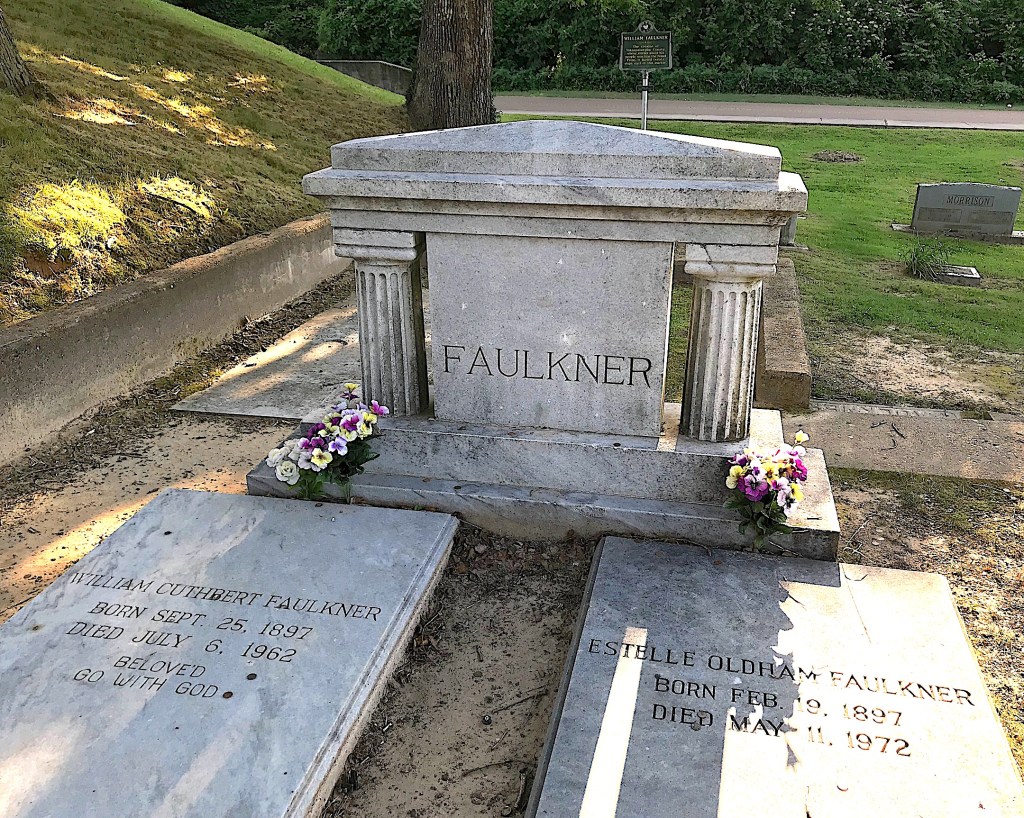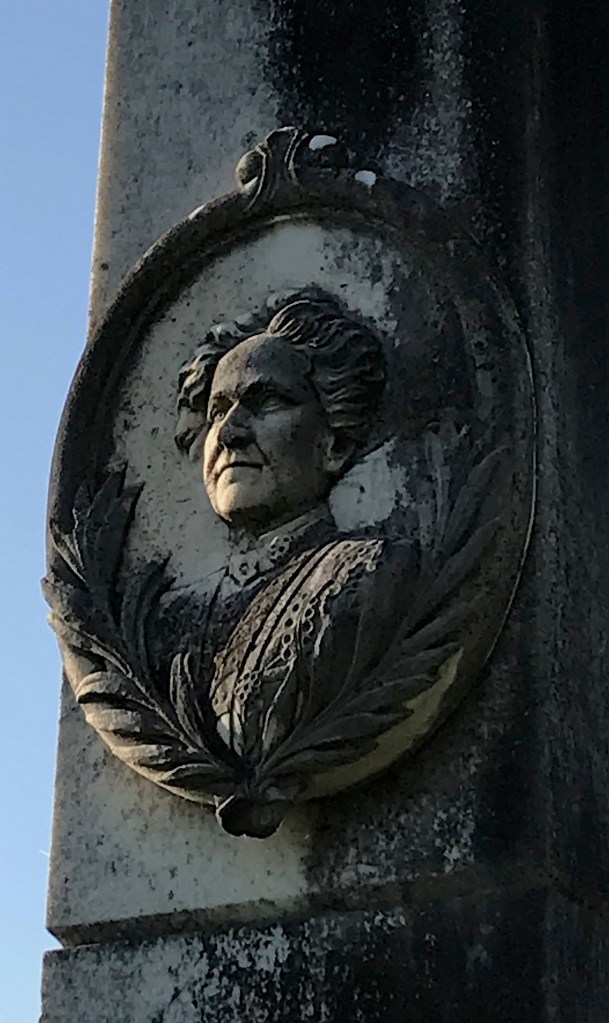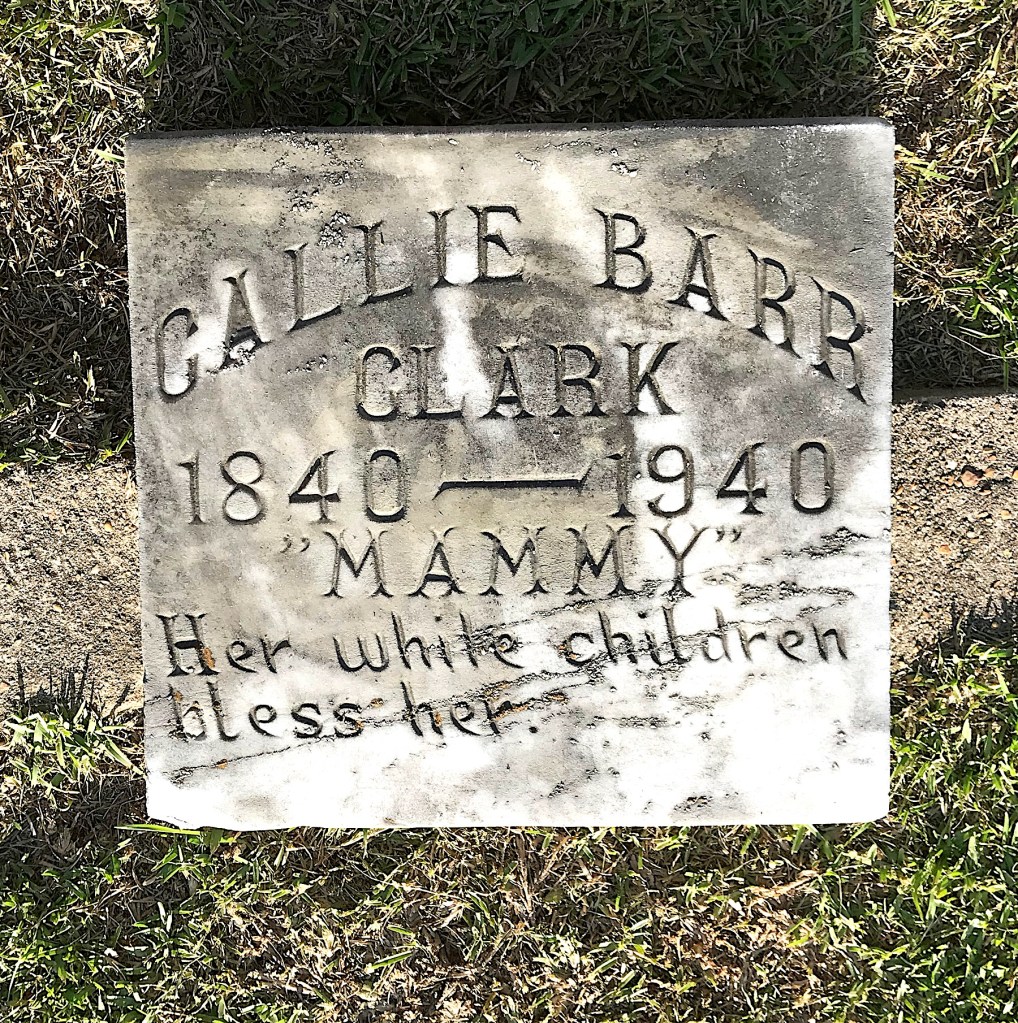We made it into Mississippi and headed for Oxford, home of the University of Mississippi. It’s better known as Old Miss. Sunset was fast approaching and I hoped to get to Oxford Memorial Cemetery before I ran out of light.
Just a logistical note. The city of Oxford owns Old Oxford, St. Peter’s, and Oxford Memorial Cemetery. I’m going to refer to it as Oxford Memorial Cemetery for clarity. There are no true dividing lines between the sections other than perhaps the age of some of the tombstones, The entire cemetery is technically owned by the city under the umbrella of Oxford Memorial Cemetery. Find a Grave has about 5,600 recorded memorials online.
The first person I went looking for is buried very close to the road on a hillside under some lovely shade. His name is so woven into Mississippi’s history that there was no way I was missing a stop at his grave, located in the St. Peter’s section.

A Nobel Laureate’s Grave
Confession time. I’m not a fan of William Faulkner’s writing. I offer my humble apologies to those of you who may be from Mississippi and/or are huge fans of his. I was assigned to read the novel Absalom, Absalom! in college and barely made it through. He’s just not my cup of tea. But I know he is beloved by many and his work is greatly treasured in literary circles. People travel from afar to Oxford just to visit his grave for good reason.
A native New Albany, Miss., Faulkner’s family moved to Oxford when he was young. When World War I began, he joined the Royal Canadian Air Force but did not serve in combat. Returning to Oxford, he attended Ole Miss for three semesters before dropping out. He moved to New Orleans, where he wrote his first novel Soldiers’ Pay in 1925. Returning to Oxford, he wrote Sartoris in 1927, his first work set in the fictional Yoknapatawpha County.
In 1929, Faulkner married Estelle Oldham, who brought with her two children from her previous marriage. Faulkner and Estelle later had a daughter, Jill, in 1933. In 1929, he published The Sound and the Fury and the following year, wrote As I Lay Dying. Hoping for greater economic success, he went to Hollywood to work as a screenwriter.
Faulkner’s fame reached its peak upon publication of Malcolm Cowley’s The Portable Faulkner and his being awarded the 1949 Nobel Prize in literature. He is the only Mississippi-born Nobel laureate. Two of his works, A Fable (1954) and his last novel The Reivers (1962), won the Pulitzer Prize for fiction. Faulkner’s economic success enabled him to purchase Rowan Oak, an estate in Oxford. He died from a heart attack on July 6, 1962, following a fall from his horse the prior month. Estelle and their daughter, Jill, lived at Rowan Oak until Estelle’s death in 1972.

One of Estelle’s children from her first marriage to Cornell Franklin, Malcolm Argyle Franklin (1923-1977), is buried in the plot with them.
Ole Miss literature students have a tradition of gathering at Faulkner’s grave to toast the Deep South’s foremost author. But no empty whiskey bottles were littering his grave on the day we stopped by.
“Her White Children Bless Her”
Further into the cemetery, I found the grave of Caroline “Callie” Barr Clark (1840-1940). Born into slavery, Callie started working for William Faulkner’s mother, Maud, in 1902. In later years, Callie lived in a cottage behind William Faulkner’s home in Oxford. She died there at the age of 100 in 1940. Both Faulkner and his brother, John, wrote affectionately of her.
Callie’s relationship with the Faulkner family might be viewed by many today as paternalistic, but I don’t doubt that their love for her was real. Over the years, Callie shared stories of pre-Civil War and Reconstruction times from her own memories with the Faulkner children. William conducted her funeral in Rowan Oak’s living room, and arranged for her burial and grave marker.
Callie is thought to be the inspiration for the character of Dilsey Gibson in The Sound and the Fury, Cal’line Nelson in Soldier’s Pay, and Molly Beauchamp in Go Down, Moses.
Faulkner dedicated Go Down, Moses to Callie in 1942, saying:
“To MAMMY Mississippi [1840-1940] who was born in slavery and gave to my family fidelity without stint or calculation of recompense and to my childhood an immeasurable devotion and love.”
A Rose By Any Other Name
Not far from Callie’s grave you can see the large Falkner family plot dominated by a large obelisk. You’ll notice the slightly different spelling of the name. There’s a rather complicated story there.
I’ve read that the family actually spelled it “Faulkner” many years before but Faulkner’s great-grandfather dropped the “u” so it became “Falkner”. William started spelling his last name “Faulkner” sometime after 1924. His brother John changed his last name to Faulkner when he published his own first novel “Men Working”. Brother Murry kept his as “Falkner” and brother Dean (who died in a 1936 plane crash) has the last name “Falkner” on his grave marker.
The obelisk in the center of the plot is for William Faulkner’s grandparents, John Wesley Thompson Falkner (1848-1922) and Sallie McAlpine Murry Falkner (1850-1906). It’s quite something to see up close, with images of John and Sallie’s profiles carved into it.


I didn’t find much about John and Sallie because apparently great-grandfather Col. William Clark Falkner was a much more colorful character who grabs the spotlight. But because he’s buried in Ripley Cemetery elsewhere in Mississippi, I’m not going to go into his background. I do know that John Falkner is thought to be the model for Bayard Sartoris in the Yoknapatawpha novels.
John Falkner was also the first president of the First National Bank of Oxford, now known as FNB Oxford-Tupelo. According to a 2020 Facebook post from the bank, John Falkner’s desk was located in the middle of the lobby so he could observe all business being conducted. William Faulkner learned of his great-grandfather’s many exploits from his grandfather over the years.
Faulkner’s parents are also buried in the Falkner plot. That’s his father, Murry, on the far right.
William Faulkner’s parents were Murry Cuthbert Falkner (1870-1932) and Maud Butler Falkner (1871-1960). Murry worked for the family-owned railroad of which the president had been his grandfather, Col. Falkner. It was when Murry and Maud were living in New Albany in 1897 that William was born. Shortly after, the family moved back to Ripley, where sons John and Murry were born. When the railroad was sold, Murry and his family moved to Oxford, where fourth son, Dean, was born. In Oxford, Murry Falkner (the father) was at one time the business manager of Ole Miss.
Alabama Faulkner
There’s one Faulkner that I wanted to mention that I didn’t even know about until I started working on this post this week.
William and Estelle Faulkner had their first child on Jan. 11, 1931 and named her Alabama. Born two months premature, the baby couldn’t consume any type of milk available in that day, including breast milk, cow’s milk, goat’s milk, or powdered milk. Formula didn’t exist then.
While incubators were a brand new feature at Memphis, Tenn. hospitals, they weren’t available at Oxford hospitals. William and his brother, Dean, raced to Memphis to obtain an incubator for Alabama, but returned home that evening to see her continue to fade. Little Alabama died the following day on January 20, 1931.
Alabama is buried in the Falkner plot. I wish I had a better picture of her grave but this is all I have. Her grave, which does not bear her name, rests in the shadow of her great-grandparents’ obelisk.
I’ll have more stories from Oxford Memorial Cemetery next time in Part II.







William Faulkner- one of my belated mother’s favorite all-time authors in English lit. I got an obituary on him that Mom saved. Faulkner’s death was close to Earnest Hemmingway’s passing, I think.
Thanks, Tom! I know W. Faulkner is beloved by many so I wanted to give him the respect he is due. I need to give him another try. I’m also glad that it sounds like your wife’s health prognosis is better than was originally thought. I hope she is doing well, I know you are supporting her as only a devoted husband such as yourself can. Will continue to pray for her full recovery.
Pingback: 💥Peace & Truth